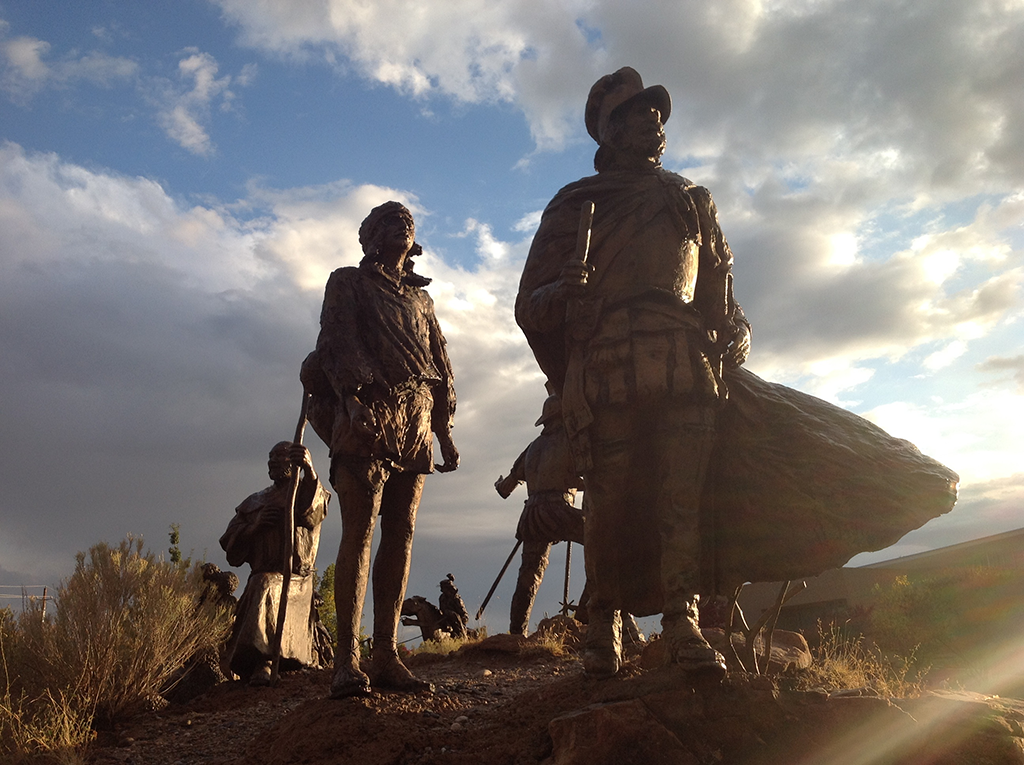As New Mexico’s state historian Rick Hendricks has put it, “Although some despise him and others admire him, Juan de Oñate towers over the history of New Mexico.”9 No matter what side of the state’s early history you are on, Oñate’s actions directed the colony’s origins for better or worse. Yet, his contested legacy became powerfully apparent during preparations to honor his colonization efforts in recent years.

Photograph by Gaylon Emerzian
A statue of Oñate was completed in Alcalde, New Mexico, in January 1998 to commemorate the 400th anniversary of his entrada. In the middle of a cold, January night, a group of people who called themselves “Friends of Acoma” (described in the New York Times as an “American Indian commando group”) used an electric saw to remove the statue’s right foot “boot, stirrup, star-shaped spur and all.” In a written statement the group made known its intentions: “We took the liberty of removing Oñate’s right foot in behalf of our brothers and sisters of Acoma Pueblo.” They went on to explain that they found “no glory” in the celebration of Oñate and they did not want their “faces rubbed in it.” Darrell Chino, an Acoma artisan that was interviewed about the incident, commented, “It was funny when it happened to the statue, but it wasn’t funny when it happened to the real people.” For centuries the Acoma people have passed down the story of the Spanish governor’s atrocities against their forebears. To them, this history was (and is) still very present.

Courtesy of The Albuquerque Journal
Other New Mexicans who identified themselves in terms of their Spanish genealogy felt differently. As Estevan Arellano, director of the Oñate Monument and Visitor Center, commented, “Give me a break—it was 400 years ago. It’s okay to hold a grudge, but for 400 years?” In addition to the statue, in April 1998 an Oñate descendant reviewed a model of a statue that was eventually erected in El Paso, Texas. He then took a helicopter to Santa Fe over the route of the old Camino Real. A troop of people dressed in the regalia of sixteenth-century Spanish soldiers hiked along the trail in memory of the event. In Santa Fe, the vice president of Spain presided over the unveiling of another Oñate statue and a fresco that honored Spanish colonization. He then moved on to Albuquerque where he participated in the groundbreaking ceremony for the National Hispanic Cultural Center.10
The 2007 dedication of the El Paso statue was met by protests. As dignitaries initiated a flag ceremony and series of speeches, a large crowd chanted “shame on you.” Several of the protestors declared the statue to be a “monument to genocide.” These commemorative activities emphasized divisions between many of the region’s Native American and Hispano inhabitants. But, even more deeply, the protests highlight the significance of multiple perspectives in history. For centuries, Pueblo people related their own stories to their immediate families and extended kin groups, but beyond their own family circles their voices had been silenced by the “official” histories presented by Spaniards, Mexicans, and then Americans. By sawing off Oñate’s right foot and protesting dedication ceremonies, they were able to reassert their perspective and their side of the story in a public venue—something that had long been denied them. From that angle, it is not difficult to understand how and why their feelings about Oñate had not subsided after four hundred years. To them, he represents not only the mutilation of the Acoma people’s ancestors. Symbolically, he also represents the violent removal of indigenous voices from the historical record over that same period of four centuries.